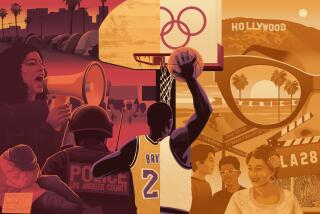Globalization of Los Angeles: The First Multiethnic Riots : American dilemma of race relations has suddenly been internationalized
- Share via
The rioting in South Los Angeles was a major upheaval in the black community, but the city’s demographics have changed since the Watts riots of 1965. South Los Angeles is now about half Latino, and Latinos also took part in the violence.
Concerns have been raised about what this participation may mean about the long-term problems that must be solved if Los Angeles is to recover and move forward into a new era in which a common interracial purpose replaces the antagonism that has done such harm.
“They’re destroying their own neighborhood,” we heard; but upwardly mobile Latinos have moved everywhere in Los Angeles. The Latino rioters were not destroying all Latino neighborhoods.
Neither were black rioters destroying all black neighborhoods. Twenty-five years of civil rights and black achievement have brought about an African-American residential diaspora. The black middle class was home watching the horror on television like everybody else.
Nor is it accurate even to say that rioting ghetto blacks and barrio Latinos teamed up to destroy their own neighborhoods. Koreatown, though it has some black and Latino residents, has no commercial concentration of either group, and yet it too was hard-hit. So were other areas. The Times has established a data base of firsthand reports on property damage. Though not yet complete, it will show, minimally, that “they” came in many colors, including white, and were on the rampage in many more places than “their own neighborhood.”
In short, these riots were not exactly Watts II. What then were they? Unless we see them whole, we cannot address the real causes.
As historians look back on the “American century,” the Immigration Reform Act of 1965 may come to seem the twin and equal of the Civil Rights Act of 1964. At the time, legislators expected neither Latin American immigration nor, much less, Asian immigration to play any great part in America’s future.
Visits to Los Angeles last week by two South Korean delegations, one led by Kim Dae Jung, show how badly that expectation was mistaken.
Kim--leader of South Korea’s major opposition party--spent two years in American exile. He knows this country well, knows that he has no formal role here and has explicitly rejected the South Korean ruling party’s call for American “reparation” for Koreatown riot damage. Kim has suggested, however, that “compensation” by the city for the failure of its police force to protect Korean-Americans is in order.
Whatever the merits of the Korean proposals, they are utterly unprecedented and prove that what Gunnar Myrdal called “the American dilemma” of race relations has suddenly been internationalized.
The roots of the internationalization lie in that mainstay of the new economic order, the globalization of labor and capital. It was the simultaneous arrival of new money and new people that created, in the enthusiasm of the late 1980s, the vision of Los Angeles as “capital of the Pacific Rim.” That vision, we are learning, has a dark side.
The money behind Korean shops does on a smaller scale what the money behind Japanese banks does. By the same token, poorly paid Korean labor in those shops does what poorly paid Mexican labor has long done in sweatshops and lettuce fields.
The emergence in Los Angeles of international financing and the availability of international labor have produced synergistic prosperity for those strong enough to seize it. They unfortunately also have produced devastating poverty for those weak in skills and resources.
The survival-of-the-fittest competition engaged in by internationally financed corporate giants also plays out among struggling small businesses with nest eggs from round the world. The same happens at the bottom for the poorest and worst educated Americans, who bring only their labor but bring it, sometimes, from afar. It is at this level, cruelly, that the poorest African-Americans are pitted against the poorest of the recent immigrants.
In short, misery can be globalized too. And the 1992 riots, though they began with black rage over the King verdict, fed on that misery. In the Soviet Union, empty shelves made a revolution. Here shelves are full but wallets are empty, and that combination, as we saw during the riots, has its own explosive power.
More to Read
Sign up for Essential California
The most important California stories and recommendations in your inbox every morning.
You may occasionally receive promotional content from the Los Angeles Times.













